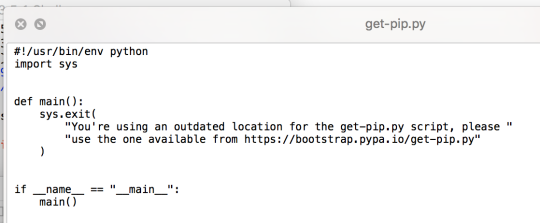While The Python Language Reference describes the exact syntax andsemantics of the Python language, this library reference manualdescribes the standard library that is distributed with Python. It alsodescribes some of the optional components that are commonly includedin Python distributions.
Python Program to detect key press: import msvcrt while True: if msvcrt.kbhit: keystroke = msvcrt.getch print(keystroke) # will print which key is pressed. Here is the Python Code. The sample output is: $ python CodeSpeedy.py b'p' b'8' b'6' b'1' b'/' b' Screenshot of the output. (Oct-11-2016, 11:37 PM) wavic Wrote: First of, check the python version. Python3.4+ and Python2.7.9+ come with pip in it. Python3 -V or python -V As I can see the uploaded date is 21 may 2016. Can't tell if it outdated it's 3.5.1, my friend who ran the script says that this is the version he used when it was working on his computer.

Python’s standard library is very extensive, offering a wide range offacilities as indicated by the long table of contents listed below. Thelibrary contains built-in modules (written in C) that provide access tosystem functionality such as file I/O that would otherwise beinaccessible to Python programmers, as well as modules written in Pythonthat provide standardized solutions for many problems that occur ineveryday programming. Some of these modules are explicitly designed toencourage and enhance the portability of Python programs by abstractingaway platform-specifics into platform-neutral APIs.
The Python installers for the Windows platform usually includethe entire standard library and often also include many additionalcomponents. For Unix-like operating systems Python is normally providedas a collection of packages, so it may be necessary to use the packagingtools provided with the operating system to obtain some or all of theoptional components.
In addition to the standard library, there is a growing collection ofseveral thousand components (from individual programs and modules topackages and entire application development frameworks), available fromthe Python Package Index.
Python Msvcrt For Machine Learning
- 3. Built-in Constants
- 4. Built-in Types
- 5. Built-in Exceptions
- 6. Text Processing Services
- 7. Binary Data Services
- 8. Data Types
- 9. Numeric and Mathematical Modules
- 10. Functional Programming Modules
- 11. File and Directory Access
- 12. Data Persistence
- 13. Data Compression and Archiving
- 14. File Formats
- 15. Cryptographic Services
- 16. Generic Operating System Services
- 17. Concurrent Execution
- 18. Interprocess Communication and Networking
- 19. Internet Data Handling
- 20. Structured Markup Processing Tools
- 21. Internet Protocols and Support
- 22. Multimedia Services
- 23. Internationalization
- 24. Program Frameworks
- 25. Graphical User Interfaces with Tk
- 26. Development Tools
- 27. Debugging and Profiling
- 28. Software Packaging and Distribution
- 29. Python Runtime Services
- 30. Custom Python Interpreters
- 31. Importing Modules
- 32. Python Language Services
- 33. Miscellaneous Services
- 34. MS Windows Specific Services
- 35. Unix Specific Services
- 36. Superseded Modules
- 37. Undocumented Modules
